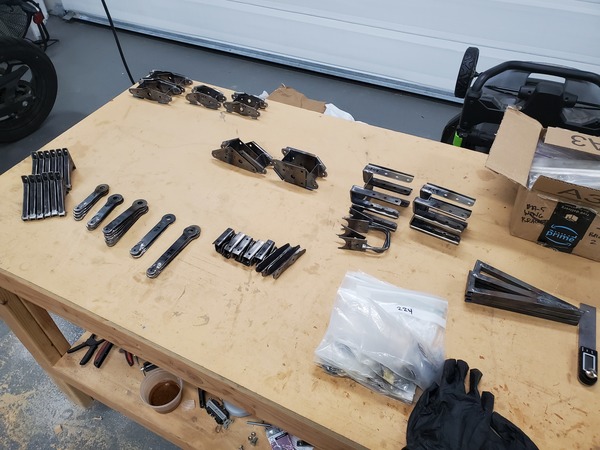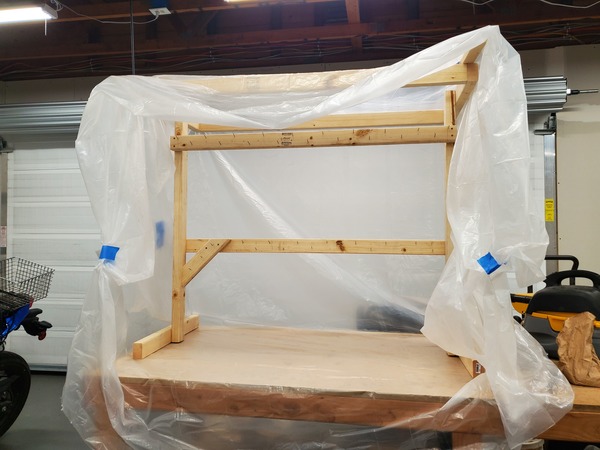Categories: all aviation Building a Biplane bicycle gadgets misc motorcycle theater
Thu, 03 Sep 2020
Building a Biplane: Painting: The Next Frontier
For the last few months since our collective COVID lockdown started, I've been working away at the brackets and wedges and other pieces that make up the wings of a some-day Charger biplane. I called Seattle Powdercoat in March asking them about their sandblasting services, and told them it would be "a few weeks" before I'd have things ready to bring in. Oh, it is to laugh.

Completed brackets
Here we are in early September, and I finally have all the brackets done that need to be done (almost: the wing root brackets that will attach the lower wings to the fuselage are waiting for later due to the specific fitment issues they will have, which depend on having both wings and fuselage ready for everything to be hooked together). I am, at long last, looking down the barrel of my longstanding nemesis:
Painting.
I've never much liked painting. It's messy and you have to wear disposable clothing and it's so easy to get wrong, and so chemical, and it just never clicked with my brain the way other parts of building things did. Yet, if I were to hire out the painting for this whole biplane project, it would add tens of thousands of dollars in labor. And lots of other people are able to paint their own planes, so why shouldn't I?
The basic idea I've got is as follows: use Stewart Systems paint (which is all waterborne, and substantially less toxic than other systems), and when it comes time to paint the big pieces, put together a paint booth inside the shop by using plastic sheeting to enclose a volume that will fit all the pieces necessary. I'll start with their EkoPrime and EkoCrylic paints for these little brackets. This all presupposes a bunch of stuff, though.
Equipment. To get set up for a job like this, I need to invest in equipment. Specifically, a nice spraygun, which is a several-hundred-dollar item. That's ok, it's not too bad, but on the back end, it demands a capable air compressor. My current compressor is a $100-special pancake compressor I got down at the big box store 10+ years ago, and is emphatically not up to the job. Stewart recommends a compressor capable of 13 cubic feet per minute (CFM) at 90 PSI, and my little compressor is probably capable of around 2 CFM. Maybe 2.5. The cheapest option that will be close to the mark is a 60 gallon, 3.7 HP compressor for $560, at 11.5 CFM (though I have it from another builder that this compressor is definitely up to the job, which is reassuring). To actually make the mark and meet or exceed 13 CFM, the cheapest option I've located is about $1200.
More important than the money, though, is the installation and space. If I were to do it strictly right, it should be bolted to the floor, and plumbed into a system of copper or iron pipes that are installed into the building, doubtless a week or more of work for me. The compressor itself is supposed to be placed 18" from the wall, meaning it would take up about three feet of space in the tightest corner I could pack it into, which is a huge amount as I ponder where I'm going to put four wings and a 20 foot long fuselage and still have any working space left over.
Fortunately, another builder opined that he set up his giant compressor on a wheeled platform, and that makes the whole thing much more palatable. It's not as ultimately safe as being bolted to the floor, but at least on wheels I have the ability to place it where it's going to be least in the way. Everything else in the shop is also on wheels for specifically this reason, so it's a pretty compelling idea.
On top of the compressor itself, there's a noticeable investment in filters and water separators and hoses and connectors to make it all work. My current compressor setup is extremely basic, though it's enough to power a small spraygun with the addition of an appropriate filter to get rid of condensed water.
Leaving aside the question of the compressor (for I will most likely live with my tiny compressor for now, since the volume of painting I need to do at this point is very small, and doesn't require the massive air capacity of the big boy), I have essentially zero experience spraypainting anything. To be sure I've shot my fair share of rattlecan paint, but I never cared if there were runs or surface imperfections. Only on one project, perhaps 15 years ago, have I attempted to make a real professional appearance using rattlecan paint. It turned out alright, but I barely remember what I did, so it's not much help in guiding my hand now.
Because my quantity of painting is so small, I'm not excited about building a proper paint booth in the shop. Thus, I decided I'd try building a micro paint booth, which is mostly a stand to hang parts from, with some plastic inexpertly draped about it.

We'll see how it works. On Biplane Forum advice, I'm going to remove the back plastic so it doesn't all just blow back in my face, and do the whole thing outdoors so I don't accidentally paint everything in the shop with a light dusting of primer.
So, I have a compressor, a tiny spraygun, with a smaller one on the way (one of those little pencil-shaped guns that modellers use, recommended for its frugal paint use and lack of overspray), hose, connectors and a painting rack. I have a good filter on the way. It's not the right setup for doing Real Painting™, but I think it'll work for what I'm doing.
The final step is to do some test spraying with my setup, and make sure I have some idea what I'm doing, and that everything I've got is goign to work like I want it to. Most of these brackets will be hidden away inside the wing, so they don't need to be beautiful, but they do need to be adequately protected from rust, so I want to have some confidence that my technique won't simply have the paint flaking off immediately.
Then, at long last, I will be able to take all these parts into the sandblaster and have them cleaned up for painting. You know, "a few weeks" later.
Posted at 15:51 permanent link category: /charger
Categories: all aviation Building a Biplane bicycle gadgets misc motorcycle theater